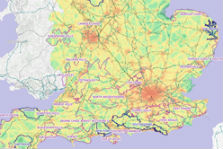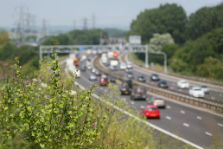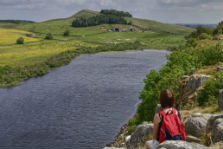CPRE view
Tranquillity is a quality of calm that people experience in places full of the sights and sounds of nature. Parks and gardens can be vital oases of tranquillity in busy towns and cities but the countryside, from our national parks to the more ‘ordinary’ countryside, is the best place to ‘escape from it all’ and recharge our batteries. Tranquillity can be damaged by the intrusive sights and sounds of man-made structures such as new roads, poorly-designed lighting and power lines. We campaign to ensure national and local policies value the tranquillity of the countryside and protect it from poor development decisions.
CPRE and tranquillity
The idea of valuing undisturbed countryside as a resource in itself emerged in the early 1990s. CPRE built on this idea to produce the first ground-breaking tranquil areas maps of England in 1995 with the Countryside Commission. These showed areas that were ‘disturbed’ and ‘undisturbed’ by urban areas (towns and cities), traffic (road, rail and airports), power stations, pylons, power lines and open-cast mines. The maps compared England in the 1960s with the 1990s, which showed a growing loss of tranquil areas: down from 75% to only 60% of the country. Further research in 2007 showed tranquil areas had reduced to around 50% of England.
CPRE built upon this work by publishing new detailed tranquillity maps in 2006. They demonstrated areas valuable for lack of disturbance and for the presence of natural features - such as trees, water and wildlife - that foster feelings of tranquillity. The maps launched a three-year campaign to press Government to recognise and protect tranquillity at all levels of public policy.
In 2012 the Government put in place a national planning policy to protect tranquillity. Some progress has been made since, but tranquil countryside remains under threat from road and airport expansion, urban sprawl and new power lines.
We want to see:
- A clearer definition of tranquillity and better policy guidance to make implementation of tranquillity policy more effective.
- The Government produce new tranquillity maps and regularly monitor changes.
- The most tranquil areas of countryside protected from development.
- New infrastructure, if it is unavoidable, that is well-designed so that it minimises harm to the tranquillity of the countryside.
- All local authorities identify and map their locally most tranquil areas, protect them with strong effective policies and promote them to their communities.
- Areas of tranquillity valued for positive, natural soundscapes and their contribution to health, well-being and quality of life.
- Recognition of the opportunities tranquil places provide for sustainable recreation, tourism and prosperity in rural areas.
Resource:

Tranquillity map of England
Using this map you can discover places to 'get away from it all' or where electricity transmission lines cut across the landscape.
Resource:

How we mapped tranquillity
This report details the research into tranquillity mapping carried out during 2006 by Northumbria University, commissioned by CPRE, and describes how the tranquillity maps were created.
The issues:

Tranquil places under threat
The countryside is our greatest reserve of tranquillity. People seek it there and they value it. Survey after survey tells us so. But the remaining most tranquil areas are often fragmented and continue to be eroded by development.
Achievements:

Our campaign successes
CPRE has pioneered work to ensure the tranquil character of the English countryside is recognised, valued and better protected. Building on these successes, we continue to campaign to keep the tranquillity of ‘designated areas’, such as national parks and AONBs, and the wider ‘ordinary’ countryside.




